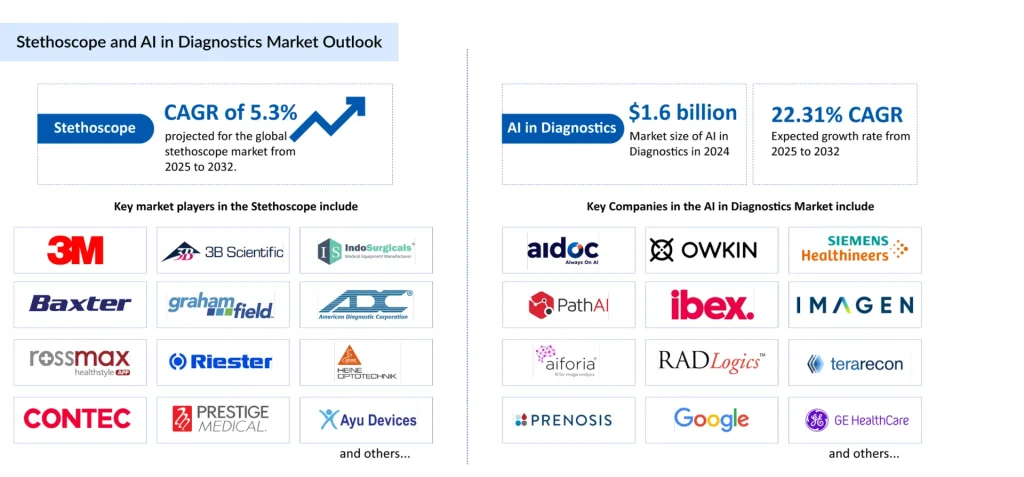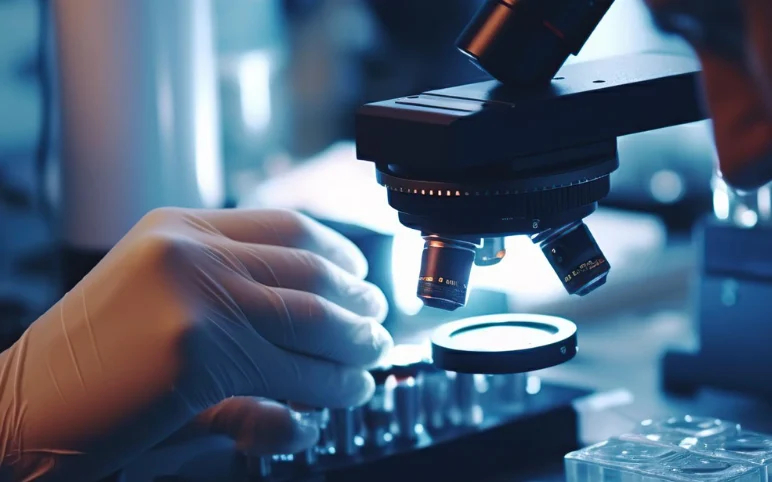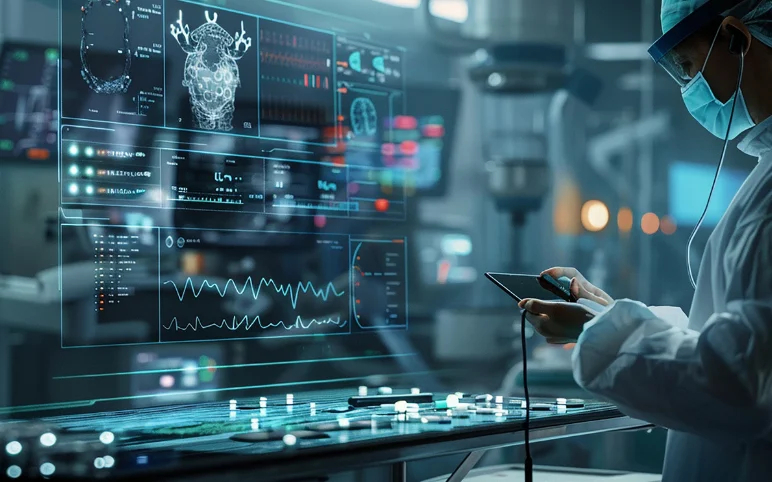AI Stethoscope: Transforming the Stethoscope Market and Cardiac Diagnostics with Unmatched Accuracy
Sep 03, 2025
Table of Contents
Each year, cardiovascular diseases claim approximately 17.9 million lives globally, accounting for about one-third of all deaths, most due to heart attacks and strokes. Despite notable advancements in imaging and a growing cardiac diagnostics market, early detection of conditions like heart failure, atrial fibrillation, and valve disease still largely depends on expensive equipment and slow referral processes. These barriers often delay interventions and result in missed opportunities for timely treatment.
Enter artificial intelligence (AI). By merging clinical expertise with machine learning, AI-powered devices are redefining how frontline healthcare providers screen, detect, and manage heart disease. The introduction of the AI stethoscope marks a milestone in this transformation, bridging the gap between traditional auscultation and advanced cardiac diagnostics.
Downloads
Click Here To Get the Article in PDF
Recent Articles
- The Revolution of Healthcare: Smart Medical Devices Transforming the Future
- Spinal Stenosis Devices Market Size to Balloon Up Owing to Increasing Prevalence & Geriatric...
- Madrigal Wins EU Approval for REZDIFFRA in MASH With Liver Fibrosis; Valneva Faces FDA License Su...
- Glucotrack Secures Ethical Approval for Extended Clinical Trial of Continuous Blood Glucose Monit...
- Ascendis Pharma’s SKYTROFA Approved by FDA for Adult Growth Hormone Deficiency; Apellis Wins FDA ...
Conventional stethoscopes, though iconic, rely solely on the clinician’s listening skills. Subtle abnormalities can be missed, especially in primary care settings. With AI-enabled tools, auscultation becomes more precise, objective, and data-driven. By integrating advanced algorithms, AI stethoscopes offer hospital-grade diagnostic accuracy at the point of care, a significant shift in the stethoscope market as it evolves from analog tools to intelligent devices.
The demand for efficient cardiac diagnostic services is surging, driven by aging populations and the rise of chronic cardiovascular diseases. Yet, patients often face long waiting times for echocardiograms or specialist evaluations. AI stethoscopes provide faster, more accurate results, boosting diagnostic confidence, reducing unnecessary referrals, and expanding the cardiac diagnostics market with disruptive innovation.
What is an AI Stethoscope?
An AI stethoscope is an advanced medical device that combines traditional auscultation with artificial intelligence algorithms. Unlike conventional tools in the stethoscope market, which depend on a clinician’s interpretation, AI stethoscopes digitally record, analyze, and compare heart sounds against large datasets to identify disease-specific patterns.

Defining AI Stethoscope Technology
At its core, an AI stethoscope acts as both a listening device and a diagnostic assistant. Equipped with high-sensitivity sensors and AI-powered software, it processes heart and lung sounds in real time and provides actionable diagnostic insights. Clinical studies have shown that this technology significantly improves detection rates for heart failure, atrial fibrillation, and valve disease — three of the most commonly underdiagnosed conditions in primary care.
How It Differs from the Best Stethoscope on the Market Today
The best stethoscopes on the market may amplify sound or digitally record it, but they still depend heavily on the clinician’s ear and judgment. AI stethoscopes go further; they interpret the data, not just present it. This means general practitioners can diagnose complex cardiac conditions in as little as 15 seconds, without relying on immediate imaging or cardiology referrals. By reducing subjectivity and enhancing accuracy, AI stethoscopes are setting a new gold standard in the stethoscope market and revolutionizing the broader cardiac diagnostics market.
Breakthrough Innovation: AI Stethoscope by Imperial College & Eko Health
The turning point for the AI stethoscope came through a landmark collaboration between Imperial College London and Eko Health, a leader in digital health technologies. Together, they envisioned a device that could combine the familiarity of a traditional stethoscope with the intelligence of advanced machine learning, bringing precision cardiac diagnostics directly to the point of care. What began as a concept has now matured into one of the most promising breakthroughs in the evolving stethoscope market.
This vision was put to the test in one of the largest trials of its kind. Nearly 12,000 patients participated in a study to assess the performance of the AI-powered stethoscope in real-world primary care settings. The results were striking: detection of heart failure doubled, identification of atrial fibrillation tripled, and diagnosis of valve disease nearly doubled compared to standard practice. For conditions that are often underdiagnosed until late stages, these gains mark a pivotal shift in the cardiac diagnostics market.
The impact of this device extends beyond accuracy. Traditional pathways for detecting heart disease often involve multiple referrals, long waits for echocardiography, and delayed treatment decisions. The AI stethoscope, however, streamlines the process by delivering reliable diagnostic insights in just 15 seconds. This speed not only improves patient outcomes but also reshapes the way cardiac diagnostic services are offered, from hospitals to community clinics.
By combining speed, accuracy, and accessibility, the AI stethoscope represents not only an incremental upgrade but a true transformation of the stethoscope market. General practitioners, who once relied solely on experience and limited tools, can now offer hospital-grade diagnostics during a routine consultation. In doing so, the technology bridges the gap between primary care and specialized cardiology, creating a ripple effect across the broader cardiac diagnostics landscape.
Recent Developments in the AI Stethoscope Ecosystem
June 2023 – Eko Health launches the CORE 500™
Eko unveiled the CORE 500™, a next-gen digital stethoscope featuring AI-driven heart disease detection, a built-in 3-lead ECG, full-color display, and advanced audio tech like TrueSound™ and noise cancellation. Designed for use across clinical settings, from urgent care to virtual visits, it marked a significant leap in the digital stethoscope evolution.
February 2024 – Sparrow BioAcoustics introduces Stethophone™
Sparrow launched Stethophone™, a smartphone-app stethoscope that turns your phone into a medical-grade auscultation tool, no hardware attachment required. It allows users to record and analyze heart and lung sounds from anywhere, echoing a shift toward mobile-first cardiac diagnostics.
September 2024 – FDA 510(k) for Stethophone Pro
Sparrow then secured FDA 510(k) clearance for its Stethophone Pro, enabling clinicians to use the app for murmur detection, phonocardiogram visualization, and sound recording with decision-support tools—bridging consumer technology with clinical diagnostics.
May 2025 – Aevice Health gains FDA 510(k) pediatric clearance for AeviceMD
Singapore-based Aevice Health achieved FDA 510(k) clearance for its AeviceMD wearable stethoscope, specifically for pediatric use (ages 3+). Designed for continuous, home-based lung monitoring, this device supports early detection of respiratory exacerbations, particularly impactful for children with asthma or chronic lung conditions. It expands the definition of digital auscultation beyond cardiology.
How AI Stethoscopes Transform Cardiac Diagnostic Services
Speed: Diagnosing in 15 Seconds
Traditional pathways for diagnosing heart conditions often involve multiple appointments, long referral chains, and delayed results. The AI stethoscope changes this paradigm by delivering actionable diagnostic insights within just 15 seconds. This speed not only enhances clinical efficiency but also ensures patients receive faster treatment decisions, reducing the burden on already stretched cardiac diagnostic services.
Accuracy: Doubling/Tripling Detection Rates
While speed is important, accuracy is critical. By consistently outperforming conventional auscultation, the AI stethoscope reduces missed diagnoses and builds greater trust in frontline cardiac care. For general practitioners, this means having a tool that elevates diagnostic confidence, aligning primary care more closely with hospital-level accuracy. This leap forward is what makes the device a true disruptor in the stethoscope market.
Accessibility: From Hospitals to Primary Care Clinics
Perhaps the most far-reaching advantage is accessibility. Advanced cardiac diagnostics have historically been confined to specialized hospitals, but AI stethoscopes put that capability directly in the hands of community doctors. By democratizing access, the technology ensures that patients in smaller clinics, rural areas, or resource-limited settings can benefit from the same high-quality screening as those in major medical centers. This decentralization could redefine how the cardiac diagnostics market grows over the next decade.
AI Stethoscope vs Traditional Cardiac Diagnostics
For decades, traditional tools like echocardiography, ECGs, and acoustic stethoscopes have formed the backbone of cardiac diagnostics. Echocardiography provides detailed imaging of the heart structure, while ECGs track electrical activity. Both are effective, but they demand specialized equipment, trained technicians, and hospital settings, factors that increase cost and delay diagnosis. Standard stethoscopes, despite being the most widely used in the stethoscope market, are highly dependent on a clinician’s ear and experience, leaving room for missed or late detection of subtle abnormalities.
This is where the AI stethoscope stands apart. By embedding advanced algorithms into a familiar device, it delivers hospital-grade insights in just seconds during a routine check-up. Conditions such as heart failure, atrial fibrillation, and valve disease, often requiring confirmatory imaging, can now be flagged earlier at the point of care. This not only accelerates intervention but also reduces unnecessary referrals, streamlining the pathway of cardiac diagnostic services.
AI Stethoscope vs Traditional Cardiac Diagnostics
| Aspect | AI Stethoscope | Traditional Cardiac Diagnostics |
| Technology | AI-powered algorithms integrated with digital auscultation | Manual auscultation with analog or electronic stethoscopes; separate devices for ECG, echo |
| Speed | Diagnoses heart failure, valve disease, and AFib in ~15 seconds | Requires multiple tests (ECG, echocardiography), taking hours to days |
| Accuracy | Doubles the detection of heart failure, nearly triples AFib detection | Detection often limited by clinician experience; early signs may be missed |
| Accessibility | Usable in primary care clinics, urgent care, and even remote settings | Advanced diagnostics mostly available in hospitals and specialized centers |
| Cost-Effectiveness | Reduces repeat visits, unnecessary referrals, and delays | Higher overall cost due to multiple tests and specialist consultations |
| Patient Experience | Non-invasive, fast, and reassuring during routine check-ups | Often involves long waits, multiple appointments, and anxiety |
| Market Impact | Driving growth in AI in the diagnostics market and digital health adoption | Mature but slower-growing stethoscope market is reliant on incremental upgrades |
From a cost perspective, the AI stethoscope is a leap forward. Echocardiography and ECG setups can cost hundreds to thousands of dollars per test, while AI-enhanced auscultation offers immediate, low-cost screening that can be scaled across primary care clinics. By cutting diagnostic delays and reducing reliance on expensive imaging for initial triage, AI stethoscopes make cardiac diagnostics more accessible, especially in resource-limited settings.
In essence, the AI stethoscope doesn’t replace echocardiography or ECGs; it complements them. It acts as a powerful front-line filter, ensuring that patients who truly need advanced imaging are identified quickly and efficiently, redefining value across the entire market.
Market Outlook: AI Stethoscope and the Future of Cardiac Diagnostics
The arrival of the AI stethoscope is more than a technological breakthrough; it’s a reflection of broader market shifts in cardiac diagnostics and digital health adoption. The push toward faster, more accurate, and accessible tools aligns closely with the rapid growth of both the AI in diagnostics market and the stethoscope market.
According to DelveInsight, the AI in Diagnostics market was valued at USD 1.6 billion in 2024 and is expected to surge at a CAGR of 22.31% between 2025 and 2032, reaching nearly USD 8 billion. This explosive growth is fueled by the rising prevalence of chronic and infectious diseases, the demand for earlier detection, and ongoing innovation from leading companies such as Aidoc, Siemens Healthineers, PathAI, Ibex, GE HealthCare, and Google LLC. As machine learning tools continue to integrate with imaging and point-of-care platforms, AI-powered diagnostics will increasingly define the frontline of healthcare delivery.

At the same time, the global stethoscope market remains robust, growing at a steady CAGR of 5.3% from 2025 to 2032. A rising geriatric population is driving the demand, higher average patient visits, and the increasing prevalence of cardiovascular and respiratory diseases. The market is also evolving rapidly, with innovations such as electronic and smart stethoscopes. Key players, including 3M, Baxter, GF Health Products, Heine Optotechnik, Medline Industries, and StethoMe, are shaping this transformation, ensuring that the stethoscope, one of the most iconic tools in medicine, continues to stay relevant in the digital era.
Regionally, North America dominates both markets, thanks to its advanced healthcare infrastructure, high burden of chronic diseases, and regulatory support for product approvals. The U.S. and Canada are leading adopters of both AI-based diagnostic platforms and electronic stethoscopes, creating fertile ground for hybrid innovations such as the AI stethoscope. This convergence signals a future where frontline providers, even in primary care, will have hospital-grade cardiac screening tools in their hands.
The AI stethoscope sits at the intersection of two booming markets, reshaping how cardiac diagnostic services are delivered and expanding access to early, cost-effective, and life-saving care.
Challenges and Considerations
Despite its promise, the AI stethoscope faces hurdles before becoming a universal tool in cardiac diagnostics. Regulatory pathways remain complex, with agencies like the FDA requiring not only safety and efficacy data but also evidence of real-world utility across diverse patient groups. Each approval milestone is critical to ensuring these devices transition smoothly from research labs to clinical practice.
Equally important is clinician training and acceptance. For decades, physicians have relied on traditional auscultation, ECGs, and echocardiography as their gold standards. Integrating AI-based devices into routine practice requires retraining, workflow adjustments, and building confidence in algorithm-driven outputs. Without buy-in from healthcare providers, even the most advanced devices risk limited adoption.
Patient trust also plays a decisive role. While many welcome technology that improves speed and accuracy, others remain skeptical about machines interpreting life-and-death conditions. Building transparency, explaining how the AI works, what it measures, and how results are verified, will be essential to earning acceptance. Overcoming these barriers will ultimately determine how quickly the AI stethoscope reshapes the broader cardiac diagnostic market.
Tuning Into the Future of Heart Health
The AI stethoscope is more than just an incremental upgrade; it represents a reimagining of one of medicine’s most iconic instruments. Where the traditional stethoscope has long been a symbol of care, the AI-powered version extends that symbolism into the era of precision medicine, equipping clinicians with insights once confined to specialized hospital settings.
By blending clinical tradition with cutting-edge intelligence, the AI stethoscope has the potential to emerge as the best stethoscope on the market due to its diagnostic accuracy and its ability to bridge the gap between primary care and advanced cardiac evaluation. Its impact will not be measured solely in detection rates or market share but in the quiet moments when a condition is caught earlier, a life is prolonged, or unnecessary suffering is prevented.
As healthcare continues its shift toward accessibility, personalization, and speed, the AI stethoscope stands as a symbol of what’s possible when technology and medicine work hand in hand. It doesn’t just transform cardiac diagnostics; it redefines the future of frontline care. And perhaps, in the years ahead, the soft click of an AI stethoscope activating will become as reassuring as the familiar sound of a heartbeat it was designed to protect.

Downloads
Article in PDF
Recent Articles
- Diagnostic Precision: The Rise of Medical Imaging Technologies and Market Trends
- Lion TCR Secures Triple FDA Milestones with IND Clearance for Chronic Hepatitis B; Corstasis Ther...
- Medtronic Receives FDA Approval for OmniaSecure™ Lumenless Defibrillation Lead and Presents Posit...
- FDA is reviewing a dangerous way to treat Peanut Allergy
- Miracor Medical’s Picso Pivotal Study; Medtronic’s Extravascular ICD; Galaxy Medical’s CENTAURI P...



